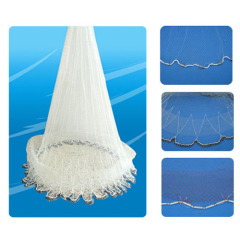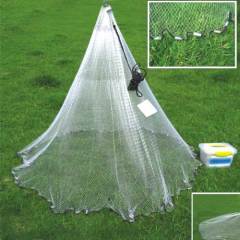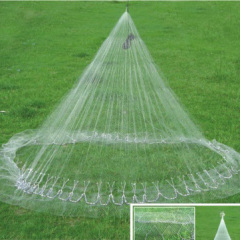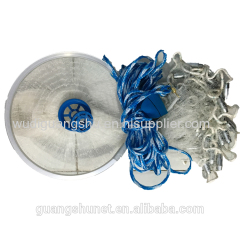
Monofilament Cast Net
1.0~30.0 USD
| Min. Order: | 1000 Piece/Pieces |
|---|---|
| Trade Term: | FOB |
| Payment Terms: | all, L/C, T/T |
| Supply Ability: | 1000000Pcs/Month |
| Place of Origin: | Zhejiang |
Company Profile
| Location: | Ningbo, Zhejiang, China (Mainland) |
|---|---|
| Business Type: | Manufacturer, Trading Company, Other |
Product Detail
| Means of Transport: | Ocean |
|---|---|
| Materia: | monofilament or multifilament |
| Twine: | 0.20mm-0.45mm |
| Mesh: | 3/4 inch-1and3/4 inch |
| Depth (Radius): | 5 foot - 15 foot |
| Production Capacity: | 1000000Pcs/Month |
| Packing: | Bale 30Kgs/PKG |
| Delivery Date: | 30days for one 20"container |
Product Description
product name :Monofilament Gill Net
Feature:
This kind of fishing net is fairly suitable for fishing operation by one or two persons in shallow sea, river, lake and pond. With its delicate feature, it is favoured by many travelers. And it occupied a good market in America, Europe, and any other countries
Specification:
1. Material: monofilament or multifilament.
2. Twine: 0.20mm-0.45mm
3. Mesh: 3/4 inch-1and3/4 inch
4. Depth (Radius): 5 foot - 15 foot
5. Package: PE apparent small bag inner package, Carton outside package.
As a professional fishing net manufacture, we are able to manufacture different net according to the customers' specification, and also able to help customers design the fishing net as per the use.

----------Monofilament Gill Net

----------Monofilament Gill Net
Introduction:
A cast net, also called a throw net, is a net used for fishing. It is a circular net with small weights distributed around its edge.
The net is cast or thrown by hand in such a manner that it spreads out on the water and sinks. This technique is called net casting or net throwing. Fish are caught as the net is hauled back in.This simple device has been in use, with various modifications, for thousands of years.
Contemporary cast nets have a radius which ranges from 4 to 12 feet (1.2 to 3.6 metres). Only strong people can lift the larger nets once they are filled with fish. Standard nets for recreational fishing have a four foot hoop. Weights are usually distributed around the edge at about one pound per foot (1.5 kilograms per metre). Attached to the net is a landline, one end of which is held in the hand as the net is thrown. When the net is full, a retrieval clamp, which works like a wringer on a mop, closes the net around the fish. The net is then retrieved by pulling on the landline. The net is lifted into a bucket and the clamp is released, dumping the caught fish into the bucket.
Cast nets work best in water no deeper than their radius. Casting is best done in waters free of obstructions. Reeds cause tangles and branches can rip nets. The net caster stands with one hand holding the landline, and with the net draped over the other arm, so the weights dangle. The line is then thrown out to the water, using both hands, in a circular motion rather as in hammer throwing. The net can be cast from a boat, or from the shore, or by wading.
There are also optional net throwers that can make casting easier. These look like a lid from a trash can, including the handle on top. The outside circumference has a deep gutter. The net is loaded along the gutter and the weights are placed inside the gutter. The net is then tossed into the water using the thrower.







